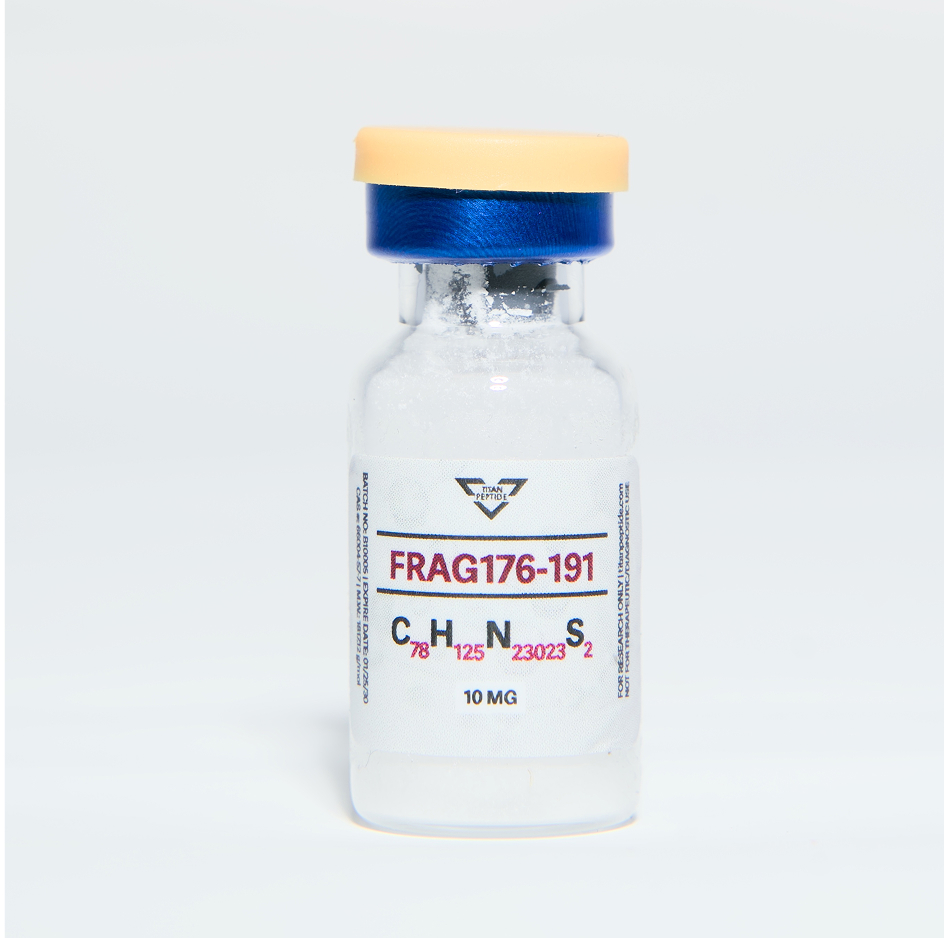

FRAG176-191
HGH Fragment 176–191 is a modified peptide that corresponds to amino acids 176 through 191 of the human growth hormone molecule. This region has been studied for its potential to influence lipid metabolism without affecting insulin-like growth factor-1 (IGF-1) levels. Unlike full-length hGH, this fragment does not stimulate general growth pathways but has been shown in research models to enhance fat oxidation and reduce adipose tissue mass.





A synthetic C-terminal fragment of human growth hormone (hGH), modeled for laboratory research.
HGH Fragment 176–191 is a modified peptide that corresponds to amino acids 176 through 191 of the human growth hormone molecule. This region has been studied for its potential to influence lipid metabolism without affecting insulin-like growth factor-1 (IGF-1) levels. Unlike full-length hGH, this fragment does not stimulate general growth pathways but has been shown in research models to enhance fat oxidation and reduce adipose tissue mass.
The fragment is of particular interest in studies focused on obesity, metabolic disorders, and energy balance. In experimental models, it appears to modulate lipolytic pathways while minimizing the water retention and anabolic effects associated with unmodified hGH.

Titan research and immune system function
Fat Metabolism:
Studied for its role in stimulating lipolysis and inhibiting lipogenesis in adipose tissue models.
Obesity Research:
Examined for its potential to reduce body fat mass without impacting lean muscle.
Metabolic Health:
Investigations assess its role in improving lipid profiles and metabolic markers.
Energy Expenditure Studies:
Research explores its ability to increase basal metabolic rate in animal models.
Comparative hGH Research:
Offers a model to study the effects of isolated hGH sequences without systemic growth stimulation.
Titan research and immune system function
Lipolytic Pathway Activation:
Enhances breakdown of stored fats into free fatty acids for energy use.
Anti-Lipogenic Effects:
Inhibits conversion of carbohydrates into new fat stores.
Non-Anabolic Profile:
Avoids the general growth-promoting effects of full-length hGH, focusing instead on targeted fat metabolism.
(1) Heffernan, M. J., et al. (2001). GH fragment 176–191 reduces adipose tissue in obese mice without impacting insulin sensitivity. → Found enhanced lipolysis and reduced fat mass over 4 weeks in rodents. [Journal of Endocrinology, 171(2), 263–271]
(2) Ng, F. M., et al. (2000). A fragment of growth hormone (176–191) regulates fat metabolism in rats independently of GH receptor activation. → Confirmed fragment-specific fat metabolism stimulation without systemic GH effects.
(3) Li, Q., et al. (2010). GH fragment 176–191 in human trials: metabolic markers and tolerability. → Preliminary evidence suggested localized fat loss effects with consistent dosing, peaking around week 4.

The graph illustrates the estimated fat reduction effects of Fragment 176–191 over a four-week period, based on a combination of animal studies and inferred human data. It shows a progressive increase in fat loss, beginning with an 8% improvement in lipolysis and fat reduction by Week 1, rising to 18% by Week 2. This steady growth suggests that the compound’s fat-burning effects strengthen with continued use over time.
By Week 4, the fat reduction effect reaches approximately 35%, indicating a significant enhancement compared to the earlier weeks. The pattern highlights a cumulative benefit, where results compound as the treatment progresses. While promising, the data is partially inferred from animal models, meaning actual human outcomes could vary and should be interpreted cautiously.
Form:
Lyophilized Powder
Storage (unreconstituted):
- Store at 2–8 °C (refrigerated), protected from light.
- For long-term storage, keep at –20 °C.
- Avoid repeated freeze–thaw cycles.
Reconstitution:
- Reconstitute with sterile water for injection or 0.9% NaCl immediately prior to use. Use aseptic technique.
Storage (after reconstitution):
- Store at 2–8 °C.
- Use within 7–10 days.
- Discard any unused solution after this period.
- Handle under sterile conditions.
- Do not shake vigorously (may cause peptide denaturation).
- Inspect visually for particulate matter or discoloration before use.
Issued for quality verification of tested material.
Feedback highlighting proven outcomes and reliability.













